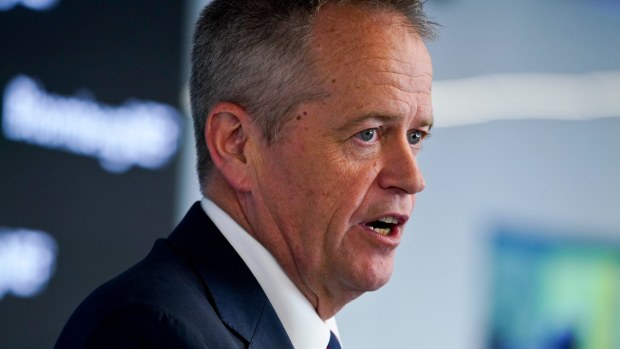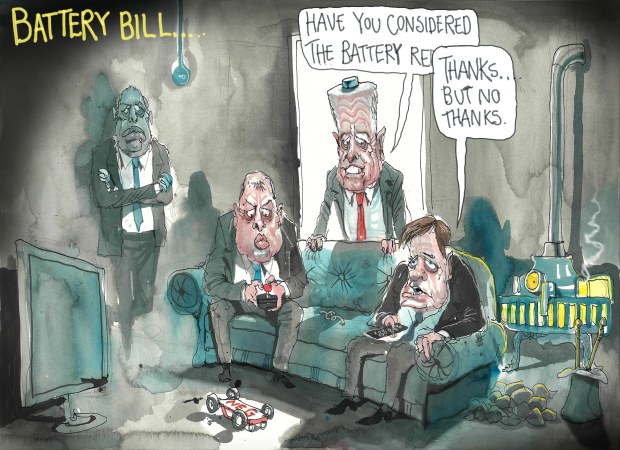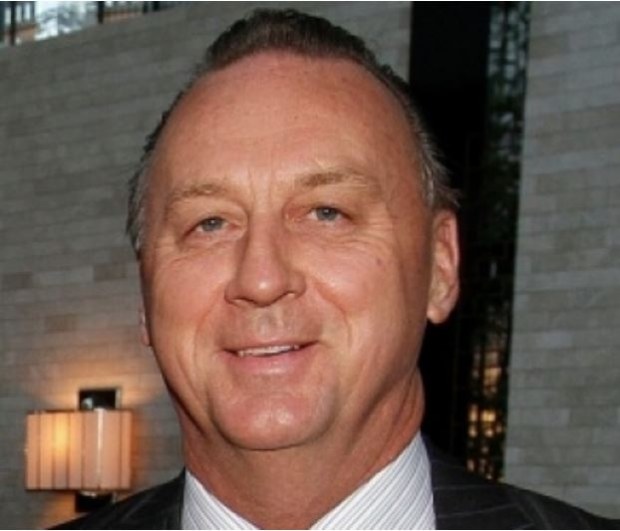Opinion

Battery Bill's welcome energy plan
Matthew StevensColumnistBill Shorten's embrace of the big battery age, and Chris Ellison's almost-successful quest to bag a financially muscular partner for the next campaign in Mineral Resources' march into the mainstream of the seaborne lithium trade, land a compelling and telling coincidence.
But the battery plan is $216 million worth of pure retail politics whose only saving grace is that it walks in helpful lock-step with the pre-election solar mission embraced by Victoria. This is just another expression of the rollout of middle-class welfare that has transformed our national energy landscape.

Bill Shorten's battery plan is $216 million worth of pure retail politics, but his broader energy policy is a very welcome beast. Ben Rushton
Australians are already carrying a heavy financial can for solar rollout. The cost of the Small-Scale Renewable Energy Scheme (SRES) that Labor introduced in 2011 is expected to top $1 billion this year and jump by more than 50 per cent to $1.64 billion in 2019.
To be clear, the cost of that scheme is passed on to all electricity consumers as a levy on every bill.
It is estimated that SRES will add about $70 to the average power bill this year, though that impost is halved for an equivalent solar-enriched home.
Shorten now wants to have 1 million household batteries installed in Australia by 2025. He proposed to actually help fund 100,000 of those directly through a $2000 rebate. Exactly how all of that might happen and how we might then manage the consequences of that, well, that is not so clear.
Unexplained challenge
Solar data-cruncher SunWiz estimates there are 28,000 solar battery systems installed in Australia right now. According to the latest data download by the Clean Energy Regulator, so far this year there have been 3623 solar-connected battery installations. That apparently leaves us on track to match last year's record of 4641 installations. And that peak was 85 per cent higher than the rate of battery connection just four years ago.
To translate political promise to a 100,000-strong in-home reality, batteries will need to be installed at an annual rate three times faster than peak battery in 2017. To secure 1 million homes with batteries would require installations to run at an average of 138,800 a year, which is 30 times the 2017 peak.

Political ambition is one thing. Dreaming is quite another.
The transformation of market logistics, technical capacity and regulatory oversight needed to hit and then manage anything like that run-rate stands an unexplained challenge.
Here Labor's putative prime minister walks under the shadow of market interventions past. The pink batt rush triggered by the Rudd government's sponsorship of home insulation left four young tradesmen dead as a result of inadequate training, failures of health and safety management and the inability of workplace safety agencies to effectively monitor the unprecedented increase of the levels of work being done.
Shorten was firm in announcing safety as a primary gateway for progress in the march to our battery-powered future. So the Clean Energy Regulator will earn a $10 million funding boost to increase its capacity to inspect and monitor the proposed rollout. And the government will invest a further $10 million in a Clean Energy Training Fund to evince a workforce capable of delivering our big battery nation.

Mineral Resources' Chris Ellison is on the brink of a $1.58 billion deal that will speed his drive up the lithium value chain.
Other initiatives
But let's step forward and imagine that Shorten's rebate lure – which covers maybe 20 per cent of the current cost of a meaningfully sized battery pack – actually works, what then? The thing about batteries is they do not last forever. So what's the disposal or recycling plan here? How does Labor plan to deal with 1 million old batteries?
Ahh, but we quibble.
If we ignore the battery cul de sac and a few of the other initiatives Shorten offered on Thursday, and we instead look at the whole, then Shorten's energy policy is a very welcome beast.
Here is the holistic energy statement that the Coalition government has been unable to forge. It is an attempt to identify where Australia might want to go and that then attempts to map out how we might get there. It is a policy that marries emissions ambitions with national energy market security through the almost universally endorsed mechanic of the National Energy Guarantee. And it is a policy that appears to recognise, and attempt to deal with, the systemic disruption caused when the national energy market is swamped by intermittent generation.
The implications of a 50 per cent of system renewable energy target by 2030 are obvious and will require active and rapid anticipation. Some traditional baseload will be left uneconomic and will need to close earlier than expected.
The MCA's questionable four are Yallourn in Victoria, Vales Point in NSW, Gladstone C in Queensland and Torrens B in South Australia. Should that happen then baseload power generation would be trimmed by 25 per cent in NSW, 22 per cent in Victoria and South Australia and 15 per cent in Queensland.
Inevitably, the MCA noted that the unanticipated loss of just one plant in 2017 – Victoria's Hazelwood power station – resulted in wholesale power prices jumping up to 80 per cent.
Bias towards gas
"The challenge for Labor and others proposing rapid increases in renewable energy is to explain how this will occur in just over a decade while ensuring reliable, low-cost, 24/7 base-load energy supply for Australian homes and businesses," the MCA said.
Too right.
But, to be fair to Shorten and his slick climate and energy spokesman, Mark Butler, that is why Labor's policy includes the prospect of support for new firming generation with a straightforward bias towards gas as a fuel.
The evolution of the mainstream power industry's reaction to Labor's energy policy will be interesting to watch. There is much in the policy that, had it been announced by the present government, would have generated conniptions. But there is a sense that the industry feels that it can work more productively with Butler and those around him than it can with the three bully boys who run the Coalition's energy strategy.
Meanwhile, at the raw materials end of batteryland, Perth's most ambitious miner (and that really is saying something), Chris Ellison, finds himself on the brink of a $1.58 billion deal that will speed his drive up the lithium value chain.
Ellison is the principal of Mineral Resources and it was an early mover in the lithium game. It runs two projects, a joint venture called Mt Marion and a wholly owned project called Wodgina.
Mt Marion exports a higher quality form of lithium called spodumene. But Wodgina is a hard-rock resource that presently direct ships what it digs up.
Higher density batteries
To give you an idea of what that difference means, consider that spodumene has a China landed cost of $575.80 a tonne. But the higher grade 6 per cent product, which is more than half of what Mt Marion produced last year, sold for an average $961 a tonne with the lower grade material being priced at $545 a tonne. Wodgina produced 3.5 million tonnes of direct ship ore that cost about $US97 a tonne to produce and that generated an average of $US110 a tonne in revenue.
Little wonder then that Ellison has long planned to push Wodgina even further up the value chain than sits Mt Marion.
As it turns out, hard rock lithium production is all the go presently because it can more cost-efficiently support production of lithium hydroxide, which is what manufacturers now want because it can produce higher density batteries.
Earlier this year the MinRes boss went out to market Wodgina's potential to lithium hydroxide producers. And Thursday revealed the fruits of that effort with announcement of a $US1.15 billion transaction in the making that would see US chemicals business Abermarle take a 50 per cent stake in Wodgina and assume marketing rights for the project's future production.
Given this plays out as both sides plan, Ellison will have re-risked both the capital investment and marketing programs ahead while Abermarle will sit with a secure supply of what is the new bedrock of the high-end battery business.
Subscribe to gift this article
Gift 5 articles to anyone you choose each month when you subscribe.
Subscribe nowAlready a subscriber?
Introducing your Newsfeed
Follow the topics, people and companies that matter to you.
Find out moreRead More
Latest In Energy
Fetching latest articles